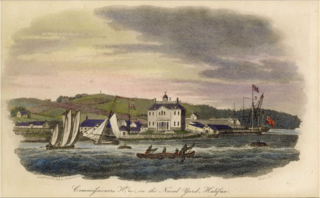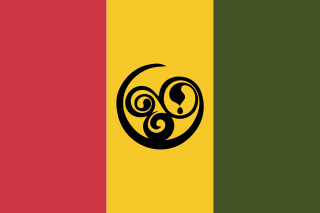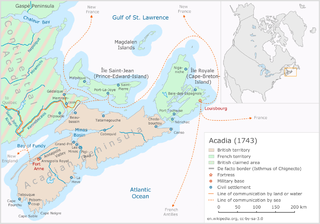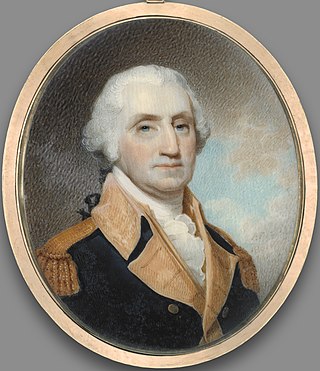
Events from the year 1786 in Canada.
Terence Richard Boyd Donahoe was a Nova Scotia opposition leader, cabinet minister, and MLA.
Sir Edward Kenny, was a Canadian politician and businessman. He co-founded the Union and Merchants' banks and served as Mayor of Halifax. He was a Conservative senator from 1867 to 1876.

Royal Naval Dockyard, Halifax was a Royal Navy base in Halifax, Nova Scotia. Established in 1759, the Halifax Yard served as the headquarters for the Royal Navy's North American Station for sixty years, starting with the Seven Years' War. The Royal Navy continued to operate the station until it was closed in 1905. The station was sold to Canada in 1907 becoming His Majesty's Canadian Dockyard, a function it still serves today as part of CFB Halifax.

St. Paul's Church is a historically evangelical Anglican church in downtown Halifax, Nova Scotia, within the Diocese of Nova Scotia and Prince Edward Island of the Anglican Church of Canada. It is located at the south end of the Grand Parade, an open square in downtown Halifax with Halifax City Hall at the northern end.

The Old Burying Ground is a historic cemetery in Halifax, Nova Scotia, Canada. It is located at the intersection of Barrington Street and Spring Garden Road in Downtown Halifax.
Alexander Cosby was born in Ireland and had a younger sister who married Richard Philipps, governor of Nova Scotia and a military man. Through this connection, Cosby was appointed major in the 40th regiment and was stationed in Nova Scotia around 1721. He looked to be appointed lieutenant governor in 1725 but the appointment went to Lawrence Armstrong. Cosby served on the Nova Scotia Council.

Black Nova Scotians are Black Canadians whose ancestors primarily date back to the Colonial United States as slaves or freemen, later arriving in Nova Scotia, Canada, during the 18th and early 19th centuries. As of the 2021 Census of Canada, 28,220 Black people live in Nova Scotia, most in Halifax. Since the 1950s, numerous Black Nova Scotians have migrated to Toronto for its larger range of opportunities. The first recorded free African person in Nova Scotia, Mathieu da Costa, a Mikmaq interpreter, was recorded among the founders of Port Royal in 1604. West Africans escaped slavery by coming to Nova Scotia in early British and French Colonies in the 17th and 18th centuries. Many came as enslaved people, primarily from the French West Indies to Nova Scotia during the founding of Louisbourg. The second major migration of people to Nova Scotia happened following the American Revolution, when the British evacuated thousands of slaves who had fled to their lines during the war. They were given freedom by the Crown if they joined British lines, and some 3,000 African Americans were resettled in Nova Scotia after the war, where they were known as Black Loyalists. There was also the forced migration of the Jamaican Maroons in 1796, although the British supported the desire of a third of the Loyalists and nearly all of the Maroons to establish Freetown in Sierra Leone four years later, where they formed the Sierra Leone Creole ethnic identity.

Richard John Uniacke was an abolitionist, lawyer, politician, member of the Nova Scotia House of Assembly and Attorney General of Nova Scotia. According to historian Brian Cutherburton, Uniacke was "the most influential Nova Scotian of his day.... His faith in Nova Scotia's destiny as a partner in a great empire was only to be equalled by Joseph Howe." He devoted 49 years to public service in Nova Scotia. He fought in the American Revolution and later sought to emancipate Catholics and Black Nova Scotians who were slaves in Nova Scotia. He is buried in the crypt of St. Paul's Church. His substantial estate is preserved as the Uniacke Estate Museum Park at Mount Uniacke.

John Albro was a merchant and political figure in Nova Scotia. He represented Halifax Township in the Nova Scotia House of Assembly from 1818 to 1826. He was also a Lieutenant-Colonel of the 4th Regiment of Halifax militia.

Richard Bulkeley was an influential administrator in Nova Scotia from 1749 to 1800. Historian Phyllis Blakeley writes that Bulkeley, "assisted 13 governors and lieutenant governors from Cornwallis to Wentworth. In half a century of service he took part in the founding of Halifax, the immigration of New Englanders and loyalists, and the prosperity of the French revolutionary wars." During his lifetime, known for hosting dignitaries and grand parties, he was known as "the Father of the Province." When he died, he was the last surviving settler who arrived with Cornwallis.
James Cochran was an Irish-born merchant and political figure in Nova Scotia, Canada. The original spelling for his surname was Cocoran or Corcoran. He represented Halifax County in the Nova Scotia House of Assembly from 1867 to 1871.

John George Pyke was an English-born merchant and political figure in Nova Scotia. He represented Halifax County from 1779 to 1793 and Halifax Township from 1793 to 1800 and from 1802 to 1818 in the Nova Scotia House of Assembly. He also became head of the Police department. He survived the Raid on Dartmouth (1751) but his father Abraham did not.
Robert Emmett Finn was a lawyer and political figure in Nova Scotia, Canada. He represented Halifax County in the Nova Scotia House of Assembly from 1906 to 1922 and Halifax in the House of Commons of Canada from 1922 to 1925 and from 1936 to 1940 as a Liberal member.

Beamish Murdoch was a lawyer, historian, and political figure in Nova Scotia. He represented Halifax township in the Nova Scotia House of Assembly from 1826 to 1830. He was born in Halifax, Nova Scotia, the son of Andrew Murdoch and Elizabeth Beamish. His family had come to Nova Scotia from the North of Ireland. His grandfather, a Presbyterian minister, Rev. James Murdoch served several parishes in the Province for 23 years. Murdoch was admitted to the Nova Scotia bar in 1822. In 1824 he was elected vice-president of the Charitable Irish Society in Halifax. He also contributed articles to the Acadian Recorder and the Acadian Magazine or Literary Mirror. Murdoch was defeated by Stephen Wastie Deblois when he ran for reelection in 1830; he was an unsuccessful candidate again in 1836 and 1840. He served as president of the Halifax Temperance Society. In 1841, Murdoch became clerk for the Central Board of Education and, in 1852, was named record for the city of Halifax. Between 1865 and 1867, he published A History of Nova-Scotia, Or Acadie. He died in Lunenburg at the age of 75. He is buried with a gravestone at the Hillcrest Cemetery.

Father Le Loutre's War (1749–1755), also known as the Indian War, the Mi'kmaq War and the Anglo-Mi'kmaq War, took place between King George's War and the French and Indian War in Acadia and Nova Scotia.c On one side of the conflict, the British and New England colonists were led by British officer Charles Lawrence and New England Ranger John Gorham. On the other side, Father Jean-Louis Le Loutre led the Mi'kmaq and the Acadia militia in guerrilla warfare against settlers and British forces. At the outbreak of the war there were an estimated 2500 Mi'kmaq and 12,000 Acadians in the region.

Robert Field (1769–1819) was a painter who was born in London and died in Kingston, Jamaica. According to art historian Daphne Foskett, author of A Dictionary of British Miniature Painters (1972), Field was "one of the best American miniaturists of his time." During Field's time in Nova Scotia at the beginning of the nineteenth century, he was the most professionally trained painter in present-day Canada. He worked in the conventional neo-classic portrait style of Henry Raeburn and Gilbert Stuart. His most famous works are two groups of miniatures of George Washington, commissioned by his wife Martha Washington.

The Halifax Club is a private club in Halifax, Nova Scotia that was established in 1862. The club serves as a meeting place for business-minded men and women. It is a place where they can "meet, toast the day's successes, dine or simply relax in a warm atmosphere of history and tradition." The Club has a substantial art collection including a self-portrait of Benjamin West and a painting by Robert Field. The Club was built by George Lang.

The North British Society was founded in Halifax, Nova Scotia in 1768, the oldest Scottish heritage society outside Great Britain. North British is an adjective used as an alternative to "Scottish".

The Province of Nova Scotia was heavily involved in the American Revolutionary War (1775–1783). At that time, Nova Scotia also included present-day New Brunswick until that colony was created in 1784. The Revolution had a significant impact on shaping Nova Scotia, "almost the 14th American Colony". At the beginning, there was ambivalence in Nova Scotia over whether the colony should join the Americans in the war against Britain. Largely as a result of American privateer raids on Nova Scotia villages, as the war continued, the population of Nova Scotia solidified their support for the British. Thousands of Loyalist refugees fled to Nova Scotia during the war, and many were resettled in the region after the signing of the 1783 Treaty of Paris as "United Empire Loyalists".















